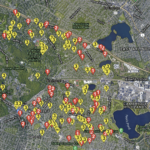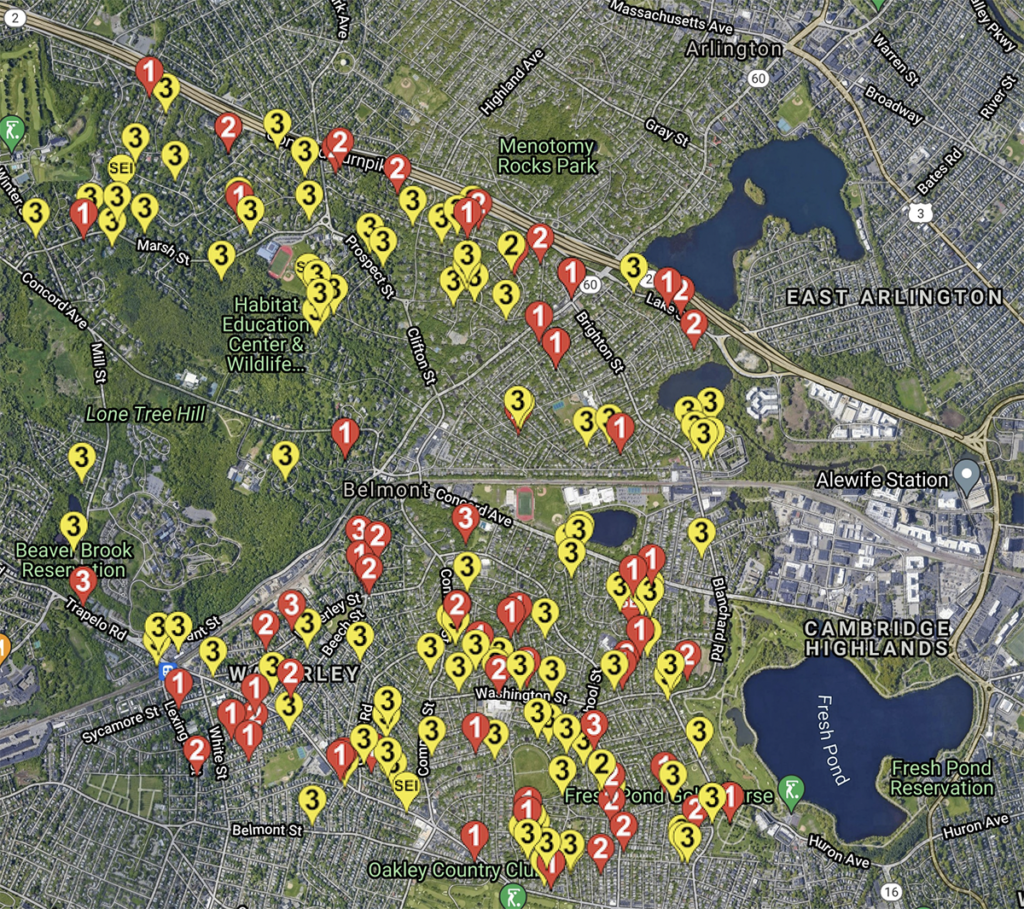
By Debora Hoffman
Think natural gas is a clean fuel? Think again. The fossil fuel, touted as a bridge fuel in the fight against CO2 emissions, is far deadlier to the planet—and our health—than is publicized.
The issue? Leaks. Leaked gas is methane, a far more potent greenhouse gas than CO2 (see “Is it Time to Get Natural Gas Out of Belmont?” BCF Newsletter, November 2020). During its first 20 years in the atmosphere, methane is 86% more potent as a greenhouse gas than CO2.
So how much gas is leaking? A lot. Statewide, gas utilities reported that 5,753 metric tons of methane leaked in 2020. Leaks occur at extraction sites, along transmission pipelines, and in aging underground pipes in urban and suburban communities—like Belmont.

Map of Belmont gas leaks created by HEET.org
If Massachusetts is going to meet our goal of an 80% reduction in greenhouse gas emissions by 2050, we will need to stop using fossil fuels to heat our homes. A coalition of climate organizations known as the Gas Leaks Allies is pushing a new idea: allow gas utilities to sell heat from clean energy.
Right now, gas companies can sell only gas. The proposal, which is at the pilot stage, allows gas utilities to replace gas pipes with water pipes which would allow buildings to access geothermal energy via heat pumps to both heat and cool. A slideshow of the nonprofit HEET’s (Home Energy Efficiency Team) proposal is available at heet.org/geomicrodistrict-introduction. “We absolutely need to fix the leaks, especially the most dangerous and biggest leaks. But the ultimate goal is to get off of gas altogether and transition as quickly as possible to renewable sources of heating and cooling,” said Ania Camargo, founder of the Gas Leaks Allies coalition.
Gas leaks affect air quality, harm trees, and endanger our health. Camargo has worked on the problem of gas leaks for years. She is passionate about having gas utilities fix leaks, and she worked to get a provision in the law in 2016 which requires companies to fix Grade 3 significant environmental impact (SEI) leaks. But she acknowledges that even though leaks are fixed every year, new ones keep popping up.
According to a Belmont Citizens Forum article five years ago, there were “80 Natural Gas Leaks in Belmont,” (BCF Newsletter, May 2016). In 2020 National Grid repaired 71 gas leaks in Belmont, but reported 112 new leaks in the same period. Statewide, there are about 15,000 unrepaired leaks.
Who Pays for Leaked Gas?
Who pays for leaked gas? We consumers do. Gas utilities pass on the cost of unburned, leaked gas to us. According to the Sierra Club, these leaks cost Massachusetts ratepayers $50 million to $128 million a year.
In 2016, Massachusetts passed an omnibus energy bill intended to increase the amount of clean energy procured by the Commonwealth. One provision requires gas utilities to repair Grade 3 leaks found during construction projects that are deemed to have an significant environmental impact.
According to HEET, gas utilities classify leaks by order of urgency:
- Grade 1 leaks are hazardous to people or property and must be repaired immediately.
- Grade 2 leaks are nonhazardous, but could be hazardous in the near future; these must be repaired within a year.
- Grade 3 leaks are nonhazardous and are expected to remain nonhazardous. Grade 3 leaks initially designated on or after January 1, 2018, are required to be repaired or eliminated within eight years.
- Grade 3 SEI are Grade 3 leaks larger than 2,000 square feet in rectangular extent;these are leaks of significant environmental impact, or SEIs. They are approximately the largest, 7%, yet contribute approximately 50% of all leak emissions. They are required to be repaired in one to three years.
So yes, some Grade 3 SEI leaks are now getting repaired. But gas companies are not required to fix older nonhazardous leaks–ever. What if gas utilities were required to pay for the leaked gas? Data from Texas, which limits how much gas companies can charge consumers for leaked gas, shows that pipes are getting replaced at a faster rate. Between 2010 and 2012, gas companies reduced their inventory of leaky pipes by 55%.
In addition, utilities are motivated to replace leaky pipes rather than fix leaks because replacement costs have a 9% to 10% rate of return as part of capital costs. Repair costs for leaks, except Grade 3 SEIs, are considered a part of doing business without a rate of return.
To replace one mile of pipe costs about $2 million; to repair one leak costs $3,000 to $4,000. New pipes can be depreciated over 50 years, so we’ll be paying for all that new infrastructure for decades—far past when we will have already switched to 100% clean energy.
Gas leaks aren’t just harmful to the environment. They’re also bad for our health. Adrienne Allen, MD, a member of the Belmont Board of Health, wrote, “Natural gas leaks pose a health risk for our residents. Most of the gas in the pipelines is fracked. Fracked gas contains a mixture of methane, volatile organic compounds, benzene … toluene, and xylene … particulate matter, and nitrogen oxides.
“These compounds—alone and worse in combination—increase rates of asthma, heart attack, stroke, preterm birth, and premature death . . . It is imperative for our health to have these lines fixed.” [See Allen’s article on page 1.]
Jay Marcotte, director of the Belmont Department of Public Works, said that he and his staff work closely with National Grid around permits for new gas lines or line replacements. The most important thing that Belmont residents should know, he said, is to call the National Grid gas leak line at 1-800-233-5325 if a gas odor is detected.
Debora Hoffman is a resident of Belmont.


Sorry, the comment form is closed at this time.